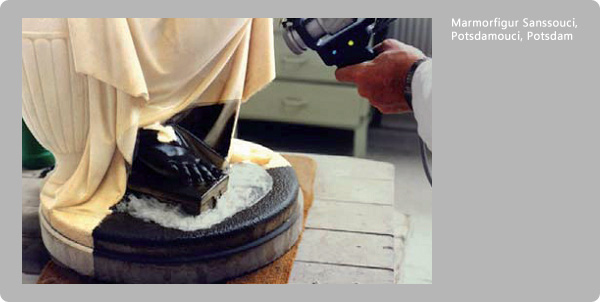As a result of technological progress in the field of laser technology in recent years - more compact design and greater reliability - lasers have now left the laboratory and opened up new, interesting applications in trade and industry. An example of this is cleaning with pulsed Q-switched Nd:YAG lasers. The driving force for the development of laser cleaning was the desire to restore valuable sculptures and monuments as gently as possible and without loss of substance. The process is now well established in monument preservation, and further applications in the area of technical cleaning have been added.
The key property that makes a laser interesting for cleaning tasks is the short duration of its light pulses. Therefore, pulsed Nd:YAG lasers with pulse durations of less than 10 ns are used. While continuous wave lasers heat the irradiated objects, Q-switched lasers deposit their energy in such a short time that a plasma is created on the irradiated surface, which spreads away from the surface at high speed in the direction of the laser beam. The transfer of heat to underlying layers is minimal, as thermal processes take place very slowly in comparison. Due to the rapid expansion of the plasma, a pressure wave is created which causes the underlying dirt or covering layers to flake off. This effect is also audible. Ideally, the absorption properties of the layer to be removed (dark, high absorption) differ from those of the object (light, metallic, reflective or transparent). Under these conditions, the cleaning process stops on the object itself as soon as the absorbent layer is removed. Examples are light limestone and sandstone.

The first significant examples of successful laser cleaning came from the Cathedral of Amiens in France. Several lasers have been in use here for years to clean the richly decorated portals. Other successful restorations were carried out using lasers on the Rouen, Lille and Notre Dame cathedrals in Paris.
In Dresden, a group of figures from the large garden was cleaned with a laser. Further laser cleaning work is underway on marble figures in Potsdam Sancouci and on the citadel in Jülich. In addition to stone cleaning, the cleaning of wood, fabric, ivory, paper, gold and bronze has also proven to be very interesting.

